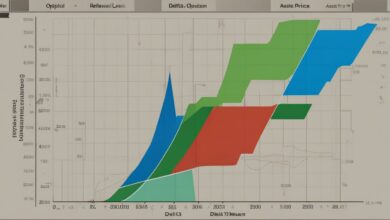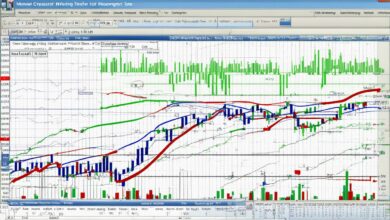Overcoming the Sunk Cost Fallacy in Trading: Strategies for Letting Go

Introduction
The sunk cost fallacy in trading refers to a cognitive bias where traders continue holding a losing position due to the emotional attachment and prior investments made. This fallacy is particularly relevant in trading psychology as it can lead traders to make irrational decisions, jeopardizing their overall portfolio.
Key takeaway: Recognizing and overcoming emotional attachment to positions is crucial for successful trading. By understanding this bias, you can avoid significant financial losses and improve your decision-making process.
In this article, several strategies will be discussed to help you let go of losing trades:
- Developing a structured trading plan
- Embracing objectivity and detachment in trading decisions
- Implementing stop-loss orders as a risk management strategy
- Focusing on opportunity costs when holding losing positions
Understanding the Sunk Cost Fallacy in Trading
The sunk cost fallacy is a cognitive bias where traders continue holding onto losing positions due to the emotional investment already made. This bias manifests when traders become fixated on recovering losses instead of making rational decisions based on current market conditions.
Key Characteristics
- Emotional Attachment to Positions: Traders often develop a strong emotional bond with their trades, making it difficult to let go even when the evidence suggests otherwise.
- Loss Aversion: The fear of realizing a loss can be so intense that traders prefer to hold onto losing positions, hoping for a market reversal.
- Commitment Bias: Once committed, traders may irrationally escalate their commitment to a failing trade, ignoring new information that contradicts their initial decision.
Impact on Trading Decisions and Portfolio Performance
This fallacy can significantly distort trading decisions:
- Holding Losing Trades: By holding onto losing positions, traders miss out on profitable opportunities elsewhere. For instance, they might overlook the potential of leveraging option greeks for more informed trading decisions.
- Increased Risk Exposure: Sticking with bad trades increases overall risk, leading to potential financial instability. Utilizing strategies like delta hedging with straddle options could help manage such risks effectively.
- Emotional Stress: The inability to let go of losing positions creates significant emotional strain, which can further impair judgment and decision-making. This stress could lead to hasty decisions.
Understanding these aspects is essential for any trader looking to overcome the sunk cost fallacy and improve their overall trading performance.
The Negative Effects of the Sunk Cost Fallacy on Traders
The sunk cost fallacy often results in significant financial losses for traders. By holding onto losing trades, you may ignore the rational decision to cut your losses and move on, leading to a depletion of your trading capital.
Consequences of Holding onto Losing Trades:
- Missed Opportunities: When you cling to a losing position, you’re tying up resources that could be better utilized elsewhere. This fixation prevents you from seizing new, potentially profitable opportunities.
- Increased Risk Exposure: Maintaining a position out of emotional attachment rather than strategic reasoning increases your exposure to further losses. It amplifies risk by concentrating your portfolio on underperforming assets.
Emotional Stress
The inability to let go of losing positions also places a heavy emotional burden on traders. The stress associated with watching the value of a trade deteriorate can lead to anxiety, impaired judgment, and burnout. This emotional turmoil can cloud your decision-making process, making it even harder to act objectively in future trades.
Recognizing these negative effects is crucial for breaking free from the sunk cost fallacy and adopting more disciplined trading strategies. A good understanding of financial derivatives can also provide traders with valuable tools and strategies to manage their investments more effectively.
Strategies for Overcoming the Sunk Cost Fallacy in Trading
1. Develop a Structured Trading Plan
Creating a structured trading plan is essential for overcoming the sunk cost fallacy in trading. A well-defined plan helps you make objective decisions based on data rather than emotions. Key components of a trading plan include:
- Entry and Exit Points: Establishing clear entry and exit points based on thorough market analysis is crucial. By defining these points in advance, you minimize the risk of emotional decision-making. For example, if you’re trading options, you might set an entry point when a stock’s price reaches a specific support level and an exit point at a predetermined resistance level.
- Risk Management Guidelines: Incorporating risk management guidelines into your trading plan is vital. This involves setting limits on how much capital you’re willing to risk on any single trade. Common risk management tools include position sizing, setting stop-loss orders, and using options strategies like protective puts, which can help mitigate losses.
- Performance Metrics: Tracking performance metrics ensures that your trading strategy remains effective over time. Keeping a trading journal where you record details of each trade—such as entry and exit points, profit or loss, and reasons for taking the trade—can provide valuable insights for refining your approach.
Implementing these elements in your trading plan helps you stay disciplined and reduces the likelihood of succumbing to the sunk cost fallacy. By adhering to predefined criteria, you can detach emotionally from trades and focus on long-term profitability.

2. Embrace Objectivity and Detachment in Trading Decisions
Adopting a detached perspective towards trades is vital for avoiding the pitfalls of the Sunk Cost Fallacy in Trading. Key techniques include:
- Mindfulness Meditation: This practice helps you maintain emotional balance, allowing you to focus on your trading plan’s entry and exit points without emotional reactivity.
- Keeping a Trading Journal: Documenting each trade, along with the rationale behind it, reinforces discipline in your trading plan. This habit reduces emotional biases, ensuring you stick to your risk management guidelines.
By embracing these methods, you effectively cut losses and keep your decision-making process aligned with a well-defined trading plan.
3. Implement Stop-Loss Orders as a Risk Management Strategy
Stop-loss orders are essential in managing risks associated with the Sunk Cost Fallacy in Trading. They act as a safety net, ensuring that you cut your losses before they mount uncontrollably. By pre-setting these orders at key support levels, you maintain discipline and adhere to your trading plan.
Key Points:
- Role of stop-loss orders: They automatically execute trades when the price hits a predetermined level, removing emotional decision-making.
- Setting stop-loss orders: Identify critical support levels through market analysis and set your stop-loss slightly below these points to avoid premature exits.
Example: If you’re holding a stock currently priced at $50 and identify a support level at $48, set your stop-loss order at $47. This way, if the price falls to this level, the order triggers an automatic exit, protecting you from further losses.
By integrating stop-loss orders into your trading plan, you enhance your risk management strategy and mitigate the detrimental effects of emotional biases. Additionally, exploring advanced strategies like the Synthetic Long Options Strategy can further refine your approach to trading. These strategies can be beneficial when used alongside basic risk management techniques such as stop-loss orders. For more insights on various trading strategies, visit our strategy page.
4. Focus on Opportunity Costs When Holding Losing Positions
Understanding opportunity costs is crucial when dealing with the Sunk Cost Fallacy in Trading. Holding onto losing positions not only ties up capital but also prevents you from reallocating resources to more promising opportunities.
Example: Suppose your trading plan includes a stock that has consistently underperformed. By holding onto this losing position, you’re missing out on potential gains from other investments that align with your entry and exit points.
To maximize returns:
- Reevaluate your portfolio: Identify underperforming assets, including those stocks that are dragging down your overall performance.
- Reallocate resources: Consider diversifying into bonds or other asset classes with better growth prospects.
- Maintain discipline: Stick to your trading plan’s risk management guidelines to effectively cut losses.
- Don’t wait for a crisis to reduce costs: It’s essential to act proactively rather than reactively when it comes to managing your investments, as suggested in this Harvard Business Review article.
This approach ensures you’re not just avoiding losses but actively pursuing better investment opportunities.

Real-Life Examples: Overcoming the Sunk Cost Fallacy in Action
Case Study 1: The 2016 Oil Price Crash
The 2016 oil price crash serves as an illuminating example of how the sunk cost fallacy can impact trading decisions. During this period, energy stocks plummeted, and many traders faced significant losses.
Traders’ Reactions:
- Holding On: A considerable number of traders held onto their losing positions, driven by an emotional attachment to their initial investments. They believed that prices would rebound, focusing on recovering their sunk costs rather than making rational decisions based on current market conditions.
- Diversification: Contrarily, some traders recognized the sunk cost fallacy and diversified their portfolios. These individuals assessed the situation objectively, reallocating resources to more promising sectors.
Analysis:
- Emotional Attachment: Those who clung to their energy stocks faced prolonged financial distress. Their refusal to let go of losing positions resulted in missed opportunities for more lucrative investments.
- Strategic Shift: Traders who diversified avoided deeper losses and improved their overall portfolio performance. By reallocating resources from struggling energy stocks to more stable or growing sectors, they not only mitigated risks but also capitalized on new opportunities.
This case underscores the critical importance of recognizing and overcoming the sunk cost fallacy in trading. The ability to detach emotionally from losing positions and make objective decisions based on current market analysis is essential for long-term success. One of the key aspects of making these objective decisions involves understanding concepts like intrinsic value, which can significantly influence trading strategies and outcomes.
Case Study 2: The 2021 Meme Stock Frenzy
Examining trader behavior during the meme stock frenzy, it’s clear that social media had a profound impact on decision-making processes. Stocks like AMC and GameStop saw unprecedented volatility, driven largely by retail traders influenced by platforms like Reddit’s WallStreetBets.
Impact on Capital Preservation:
- Traders Who Exited Based on Objective Analysis:
- These traders focused on data-driven strategies to navigate the chaos. By setting predefined exit points and sticking to their trading plans, they managed to preserve capital and avoid significant losses.
- Example: A trader who bought GameStop shares at $20, set a stop-loss order at $15, and sold at $150 when the stock surged, thereby securing substantial gains while mitigating risk.
- Traders Who Succumbed to Emotional Biases:
- Many traders held onto their positions too long due to emotional attachment and fear of missing out (FOMO). This led to substantial financial losses as the stocks eventually plummeted.
- Example: An investor who bought AMC shares at $5 and refused to sell even when the price hit $60, only to see it crash back down, exemplifies the negative effects of ignoring objective analysis.
This case study highlights how overcoming the sunk cost fallacy through disciplined strategies can lead to better capital preservation during volatile market events.

Conclusion: Navigating Market Complexities with Disciplined Strategies
Overcoming biases in trading, such as the sunk cost fallacy, is crucial for long-term success. Emotional attachment to positions can cloud judgment and lead to significant financial losses. By implementing disciplined strategies, you can enhance decision-making and better navigate market complexities.
Key Takeaways:
- Develop a Structured Trading Plan: Define entry and exit points, risk management guidelines, and performance metrics. Implementing strategies that suit your trading style can further enhance this process.
- Embrace Objectivity and Detachment: Use mindfulness techniques and maintain a trading journal to help maintain focus.
- Implement Stop-Loss Orders: Set stop-losses at key support levels to manage risk effectively.
- Focus on Opportunity Costs: Reallocate resources from losing positions to better investment opportunities. Understanding option moneyness can provide valuable insights in this regard.
- Consider Selling Call Options Before Expiry: A common question among traders is “can you sell a call option before the expiry date?”, which could be a strategic move depending on the market conditions.
Adopting these strategies will help improve your capital preservation and ensure more rational, objective trading decisions. Additionally, being aware of the consequences of decreasing implied volatility can further assist in managing risks and maximizing returns in a volatile market.








